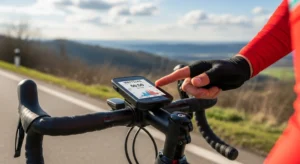Cycling offers freedom, fitness, and fun, but the weather doesn’t always cooperate. Whether you’re commuting to work, training for a race, or simply enjoying a ride, different weather conditions can present challenges. However, with the right preparation and knowledge, you can cycle safely and comfortably in almost any weather. In this guide, we’ll break down how to tackle cycling in different weather conditions, ensuring you’re ready for any forecast.
1. Cycling in the Rain
Rainy weather can make cycling more challenging, but it doesn’t mean you have to skip your ride. Here’s how to stay safe and comfortable when the skies open up.
What to Wear:
-
Waterproof Gear: Invest in a good-quality waterproof jacket, pants, and shoe covers to stay dry. Look for breathable fabrics to prevent overheating.
-
Waterproof Gloves: Keep your hands warm and dry with waterproof gloves.
-
Helmet with a Visor: A helmet with a visor or a rain cover helps keep water out of your eyes.
Bike Maintenance Tips:
-
Mudguards: Install mudguards or fenders on your bike to reduce the amount of water and dirt splashing onto your clothes and face.
-
Brake Pads: Wet conditions can affect your braking performance. Make sure your brake pads are in good condition, and consider upgrading to water-resistant ones for extra safety.
-
Lights and Reflectors: Rain often comes with overcast skies, reducing visibility. Use front and rear lights and add reflective elements to your bike and gear.
Safety Tips:
-
Ride Smoothly: In the rain, roads can be slippery, especially when it’s just started raining. Avoid sudden turns and keep your movements smooth to prevent slipping.
-
Avoid Puddles: Puddles can hide hazards like potholes, so try to avoid riding through them.
-
Check Tire Pressure: Under-inflated tires can make riding in wet conditions more challenging, so keep them inflated according to the manufacturer’s recommendations.
2. Cycling in the Heat
Cycling in hot weather can be a great workout, but it also comes with its own set of challenges. The key is staying cool and hydrated to avoid heat exhaustion or dehydration.
What to Wear:
-
Light-Colored Clothing: Choose light-colored, moisture-wicking clothes to reflect the sun’s rays and keep you cool.
-
Breathable Fabrics: Opt for breathable, moisture-wicking jerseys, shorts, and socks that allow air circulation and wick sweat away from your body.
-
Helmet Ventilation: A well-ventilated helmet helps keep your head cool.
Hydration Tips:
-
Drink Water: Make sure to hydrate before, during, and after your ride. Carry a water bottle and stop regularly to drink.
-
Electrolytes: Consider drinking sports drinks with electrolytes to replace lost minerals, especially during long rides in the heat.
Safety Tips:
-
Avoid Peak Heat: Try to avoid cycling during the hottest part of the day, typically between 10 a.m. and 4 p.m. Early mornings or late evenings are ideal for a cooler ride.
-
Sun Protection: Apply sunscreen to exposed skin to protect against sunburns. Sunglasses can protect your eyes from harmful UV rays and reduce glare.
-
Take Breaks: If you start feeling overheated, stop in a shaded area and rest until your body cools down.
3. Cycling in the Cold
Cold weather presents different challenges for cyclists, but with the right gear and preparation, you can still enjoy riding in winter.
What to Wear:
-
Layer Up: Wear multiple layers of clothing. Start with a moisture-wicking base layer, add an insulating layer, and finish with a windproof or waterproof outer layer.
-
Thermal Gloves and Socks: Keep your hands and feet warm with thermal gloves and socks. Consider wearing toe covers or booties to protect your feet from the cold.
-
Face Mask or Balaclava: A face mask or balaclava can protect your face from the cold wind and frostbite.
Bike Maintenance Tips:
-
Tires: Cold weather can make roads icy and slick. Consider switching to winter tires with more grip for better traction on slippery surfaces.
-
Lubrication: Cold temperatures can cause bike chains to freeze. Use a wet lube that works well in cold conditions to keep your bike running smoothly.
Safety Tips:
-
Visibility: In winter, daylight hours are shorter, and visibility can be poor due to fog or snow. Always use lights on your bike and wear reflective clothing.
-
Watch for Ice: Icy patches on the road are a significant hazard. Stay alert and avoid riding on areas that may be icy, such as bridges or shaded spots.
4. Cycling in Windy Conditions
Strong winds can make cycling a struggle, but there are ways to minimize its impact and make your ride more enjoyable.
What to Wear:
-
Windproof Clothing: A windproof jacket or vest can protect you from the chill and reduce drag.
-
Aero Helmet: A helmet with a streamlined design can help reduce wind resistance.
Safety Tips:
-
Watch for Crosswinds: Crosswinds can push you off course, especially on narrow roads. Keep a firm grip on your handlebars and be prepared for sudden gusts.
-
Pace Yourself: Headwinds can make riding more difficult. If you’re riding into a headwind, adjust your pace and conserve energy. When the wind is at your back, you can enjoy a faster, easier ride.
-
Positioning: Lower your body position to reduce the amount of wind resistance, especially when riding at higher speeds.
5. Cycling in Snow
Riding in snowy conditions is challenging, but with the right approach, you can stay safe and even enjoy the beauty of winter landscapes.
What to Wear:
-
Extra Layers: Wear additional layers to protect your body from the cold. A thermal jacket and tights can help keep you warm.
-
Waterproof Gear: Snow can quickly melt and leave you wet. Waterproof gloves, socks, and shoe covers will keep you dry and warm.
Bike Maintenance Tips:
-
Studded Tires: Consider using studded tires, which provide extra traction on icy and snowy surfaces.
-
Regular Cleaning: Snow and salt from roads can damage your bike. Clean your bike thoroughly after each ride, and apply anti-rust lubricant to protect your components.
Safety Tips:
-
Slow Down: Snow and ice can make surfaces slippery. Ride slowly and carefully to avoid losing control.
-
Watch for Frozen Patches: Ice is harder to spot under snow, so always be cautious about potentially hidden hazards.
-
Stay Visible: Snowy conditions can reduce visibility, so be sure to wear bright, reflective clothing and use your bike lights.
Conclusion
Cycling in different weather conditions requires the right preparation, gear, and mindset. Whether you’re riding in the rain, battling the heat, or cycling through winter’s chill, each weather challenge can be tackled with the proper strategies. By dressing appropriately, maintaining your bike, and staying alert, you can enjoy cycling year-round, regardless of the weather. Stay safe, and don’t let the elements stop you from hitting the road!




